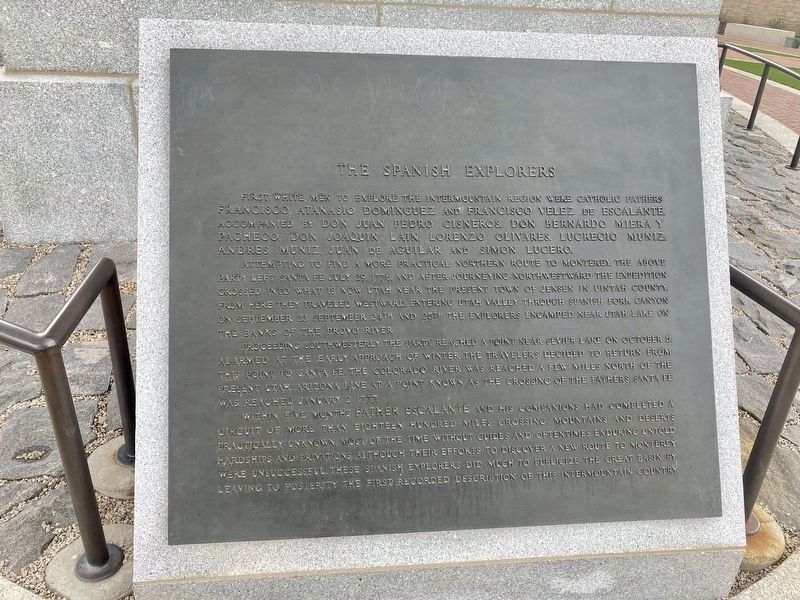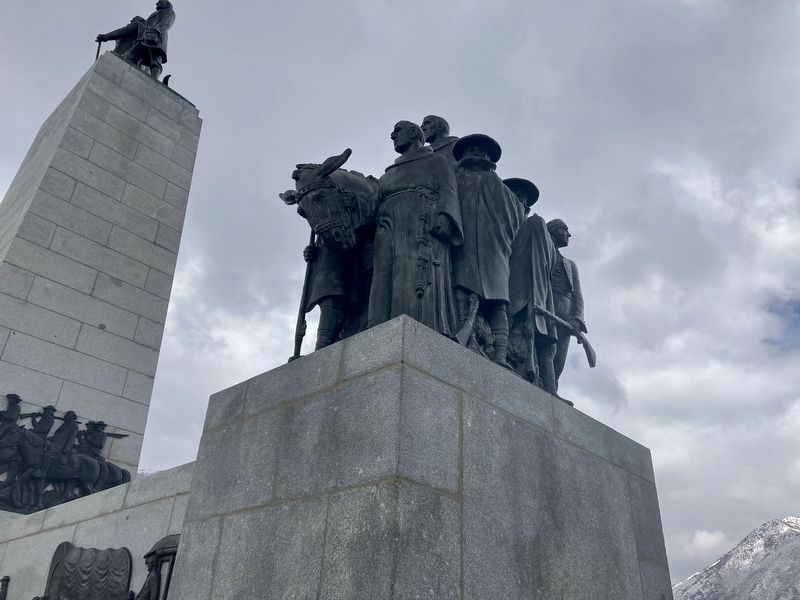University in Salt Lake City in Salt Lake County, Utah — The American Mountains (Southwest)
The Spanish Explorers
Attempting to find a more practical northern route to Monterey the above party left Santa Fe July 29, 1776. And after journeying northwestward the expedition crossed into what is now Utah near the present town of Jensen in Uintah County from here they traveled westward. Entering Utah Valley through Spanish Fork Canyon on September 23. September 24th and 25th the explorers encamped near Utah Lake on the banks of the Provo River.
Proceeding southwesterly the party reached A point near Sevier Lake on October 5. Alarmed at the early approach of winter. The travelers decided to return from this point to Santa Fe. The Colorado River was reached a few miles north of the present Utah-Arizona line at a point known as the Crossing of the Fathers. Santa Fe was reached January 2, 1777.
Within five months Father Escalante and his companions had completed a circuit of more than eighteen hundred miles, crossing mountains and deserts practically unknown. Most of the time without guides and oftentimes enduring untold hardships and privations. Although their efforts to discover a new route to Monterey were unsuccessful, these Spanish explorers did much to publicize the Great Basin by leaving to posterity the first recorded description of this intermountain country.
Topics. This historical marker is listed in this topic list: Exploration. A significant historical date for this entry is July 29, 1776.
Location. 40° 45.116′ N, 111° 48.977′ W. Marker is in Salt Lake City, Utah, in Salt Lake County. It is in University. Marker can be reached from East Sunnyside Avenue. Marker is at "This is the Place" monument. Touch for map. Marker is at or near this postal address: 2601 East Sunnyside Avenue, Salt Lake City UT 84108, United States of America. Touch for directions.
Other nearby markers. At least 8 other markers are within walking distance of this marker. This is the Place Monument (a few steps from this marker); Sesquicentennial Mormon Trail Wagontrain (about 300 feet away, measured in a direct line); Pioneer Pavilion (about 500 feet away); Smoot Hall at Brigham Young Academy (about 500 feet away); Pioneer Children’s Memorial (about 500 feet away); Orson Pratt Observatory (about 600 feet away); Pine Valley Chapel (about 600 feet away); Thomas Phillip White Cabin (about 600 feet away). Touch for a list and map of all markers in Salt Lake City.
Credits. This page was last revised on February 16, 2023. It was originally submitted on May 16, 2021, by Connor Olson of Kewaskum, Wisconsin. This page has been viewed 496 times since then and 107 times this year. Photos: 1, 2. submitted on May 16, 2021, by Connor Olson of Kewaskum, Wisconsin. • Bill Pfingsten was the editor who published this page.
Editor’s want-list for this marker. Wide are view of the marker and its surroundings. • Can you help?

